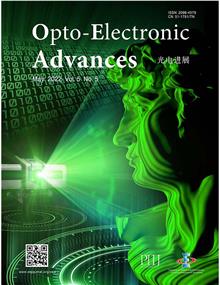 View fulltext
View fulltext
High resolution imaging is achieved using increasingly larger apertures and successively shorter wavelengths. Optical aperture synthesis is an important high-resolution imaging technology used in astronomy. Conventional long baseline amplitude interferometry is susceptible to uncontrollable phase fluctuations, and the technical difficulty increases rapidly as the wavelength decreases. The intensity interferometry inspired by HBT experiment is essentially insensitive to phase fluctuations, but suffers from a narrow spectral bandwidth which results in a lack of effective photons. In this study, we propose optical synthetic aperture imaging based on spatial intensity interferometry. This not only realizes diffraction-limited optical aperture synthesis in a single shot, but also enables imaging with a wide spectral bandwidth, which greatly improves the optical energy efficiency of intensity interferometry. And this method is insensitive to the optical path difference between the sub-apertures. Simulations and experiments present optical aperture synthesis diffraction-limited imaging through spatial intensity interferometry in a 100 nm spectral width of visible light, whose maximum optical path difference between the sub-apertures reaches 69λ. This technique is expected to provide a solution for optical aperture synthesis over kilometer-long baselines at optical wavelengths.
An exceptional-point (EP) enhanced fiber-optic bending sensor is reported. The sensor is implemented based on parity-time (PT)-symmetry using two coupled Fabry-Perot (FP) resonators consisting of three cascaded fiber Bragg gratings (FBGs) inscribed in an erbium-ytterbium co-doped fiber (EYDF). The EP is achieved by controlling the pumping power to manipulate the gain and loss of the gain and loss FP resonators. Once a bending force is applied to the gain FP resonator to make the operation of the system away from its EP, frequency splitting occurs, and the frequency spacing is a nonlinear function of the bending curvature, with an increased slope near the EP. Thus, by measuring the frequency spacing, the bending information is measured with increased sensitivity. To achieve high-speed and high-resolution interrogation, the optical spectral response of the sensor is converted to the microwave domain by implementing a dual-passband microwave-photonic filter (MPF), with the spacing between the two passbands equal to that of the frequency splitting. The proposed sensor is evaluated experimentally. A curvature sensing range from 0.28 to 2.74 m?1 is achieved with an accuracy of 7.56×10?4 m?1 and a sensitivity of 1.32 GHz/m?1, which is more than 4 times higher than those reported previously.
Integrating deformable mirrors within the optical train of an adaptive telescope was one of the major innovations in astronomical observation technology, distinguished by its high optical throughput, reduced optical surfaces, and the incorporation of the deformable mirror. Typically, voice-coil actuators are used, which require additional position sensors, internal control electronics, and cooling systems, leading to a very complex structure. Piezoelectric deformable secondary mirror technologies were proposed to overcome these problems. Recently, a high-order piezoelectric deformable secondary mirror has been developed and installed on the 1.8-m telescope at Lijiang Observatory in China to make it an adaptive telescope. The system consists of a 241-actuator piezoelectric deformable secondary mirror, a 192-sub-aperture Shack-Hartmann wavefront sensor, and a multi-core-based real-time controller. The actuator spacing of the PDSM measures 19.3 mm, equivalent to approximately 12.6 cm when mapped onto the primary mirror, significantly less than the voice-coil-based adaptive telescopes such as LBT, Magellan and VLT. As a result, stellar images with Strehl ratios above 0.49 in the R band have been obtained. To our knowledge, these are the highest R band images captured by an adaptive telescope with deformable secondary mirrors. Here, we report the system description and on-sky performance of this adaptive telescope.
Object identification and three-dimensional reconstruction techniques are always attractive research interests in machine vision, virtual reality, augmented reality, and biomedical engineering. Optical computing metasurface, as a two-dimensional artificial design component, has displayed the supernormal character of controlling phase, amplitude, polarization, and frequency distributions of the light beam, capable of performing mathematical operations on the input light field. Here, we propose and demonstrate an all-optical object identification technique based on optical computing metasurface, and apply it to 3D reconstruction. Unlike traditional mechanisms, this scheme reduces memory consumption in the processing of the contour surface extraction. The identification and reconstruction of experimental results from high-contrast and low-contrast objects agree well with the real objects. The exploration of the all-optical object identification and 3D reconstruction techniques provides potential applications of high efficiencies, low consumption, and compact systems.
A recent article in the Opto-Electronic Advances (OEA) journal from Prof. Qian Chen and Prof. Chao Zuo’s group introduced a new and efficient 3D imaging system that captures high-speed images using deep learning-enabled fringe projection profilometry (FPP). In this News & Views article, we explore potential avenues for future advancements, including expanding the measurement range through an extended number-theoretical approach, enhancing quality through the incorporation of horizontal fringes, and integrating data from other modalities to broaden the system's applications.













